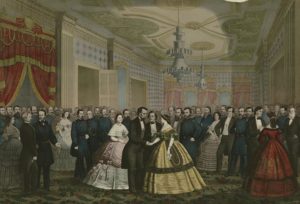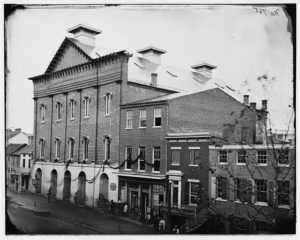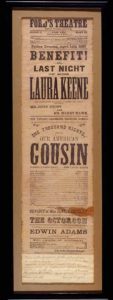She found herself in Washington like millions before and since, a young woman from somewhere else—in this case Connecticut—quickly taken with her newfound closeness to the pomp of the Federal seat of government.
Back in 1865, Washington was also capital of a nation split by a brutal civil war entering its last months. Sarah Russell, a minister’s daughter, would twice see President Lincoln with her own eyes—at the White House on the evening of his second inauguration, March 4, and a few weeks later on Good Friday, April 14, Ford’s Theatre.

Currier & Ives
Jump ahead four decades to a roomy two-story home with picket fence on Lee Highway in the East Fall Church neighborhood. Sarah Norton Russell Eastman (1847-1939), mother of two impressive young men and wife of a Union veteran, is placing her memories onto the modest lines of a composition book. Points of popular history supplement her recall and at times a fact or two come out wrong.
But it’s Mrs. Eastman’s brief glimpses of Lincoln, both in celebration and mortally wounded, that shine like well-kept heirlooms.
“His shirt was open showing blood on his chest.”
Arlington Public Library’s Virginia Room is home to the Eastman-Fenwick Collection, a large mix of personal papers, Civil War and World War I front-line correspondence, photographs, maps and other materials that include Sarah Eastman’s, and those of several generations including her granddaughter’s husband, Virginia delegate, state senator and gubernatorial candidate Charles R. Fenwick. The Arlington Democrat was a key proponent of regional mass transit and his name is attached to Metro’s Yellow Line span of the 14th Street Bridge. Fenwick was also a political intimate of John and Robert Kennedy.
The Eastman-Fenwick House, 6733 Lee Highway, is still a family home.
----------------------------------------------------------------------------------------------------------------------------
A transcription of Sarah Eastman's account of seeing Abraham Lincoln during March and April 1865:
My Recollection of the Assassination of
President Abraham Lincoln.
In January 1865, before the close of the
Civil War, I came to Washington to live, and
witnessed many of the exciting scenes of
that period.
I saw President Lincolns second
Inauguration and helped dress my Sister to
ride in a float in the parade, which was
an impromptu affair. Thirteen girls dressed
in white with red white and blue, carrying
flags rode on the float.
That evening I attended the reception to

President Lincoln’ second inaugural reception
The President at the White House. At the
front door a certain number of persons were
admitted at a time, and when the door was
closed the crowd surging back actually
lifted me off the my feet. After entering, persons
passed through the hall into the Blue
Room, and after shaking hands with the
President and Mrs. Lincoln passed into
the East Room, making their exit through
[page 2]
one of the windows onto a platform extending
from the windowsill to the front fence, then
down a few steps to the pavement.
My father had been a minister in
Connecticut, and was opposed to the Theatre, so it
was after long urging and the argument that

Ford's Theatre, April 1865
General Grant was to be at the Theater with the
President that evening, that he gave his consent
to my going. I sat in the dress circle nearly
opposite the box in which the President was seated.
The play was Our American Cousin. When the
Presidential Party came in, Lord Dundreary was
just asking the conundrum [“]Why does a dog
wag his tail[?”], and after the applause given the
President he repeated it. The play went
on, then at a moment when the stage was
clear there was a pistol flash and John Wilkes
Booth jumped from the box in which the
President was sitting onto the stage. In jumping
his foot caught in the flag decorating the box
and he apparently sat for an instant on the stage.
Rushing across the stage, about in the middle,
he turned, brandishing a dagger that glistened
[page 3]
in the gas light, and calling out “Sic Semper Tyranus [sic]”
was gone into the alley where a boy was holding
his horse. Being familiar with the Theater he
knew how to arrange the passages so that nothing
would obstruct his course.
For a moment every one was dazed, there was
quiet, but almost immediately word spread
around The President has been shot. Then the
confusion was awful. Women fainted, some tried
to climb over the backs of chairs, men rushed on to
the stage, some climbed to the box with water,
Laura Keene came on the stage and with arms
outstretched implored the audience to be calm.
Twice she came out in that manner. After that
she was in the box with Mrs. Lincoln.
In going out I reached the top of the stairs just
as the President was being carried down on a
stretcher. Laura Keene was following calling
[“]Make way for Mrs. Lincoln,[“] who was crying
[“]Let me get the assassin, Oh take me to him.[“]
His shirt was open showing blood on his chest.
He was taken to a house opposite where he
died the next morning.
[page 4]
There was a plot to assassinate some of
the Cabinet that night. Secretary of State Seward
was attacked, on his sick bed, and seriously
injured, his Son having a tussle with the assassin.
Secretary of War Stanton was an intended
victim but was not found where the plotters
supposed him to be. General Grant who was
advertised to be at the Theater was suddenly
called out of the city.
Accompanying the President and Mrs. Lincoln
was Major Rathburn [sic] and Miss Harris – afterward
married.
There were six persons in the plot
Mrs. Surratt, at whose house on H St near 5th NW
their meetings were held, her Son John H. Surratt,
Payne, who attacked Secretary Seward, Harrold [sic],
Atzerolt [sic] and Mudd. After trial three were
executed - hung – on the grounds of Old Capitol Prison.
(The ground now occupied by the New Senate Office Bldg.)
Mrs. Surratt, Payne, Atzerolt. The others were
banished to Dry Tortugus [sic].
A few words about Miss Keene
[page 5]
The performance that evening was
advertised as a Benefit, also her last night.
The President, with a full house must have
been an incentive to do her best. She was
gowned in white satin brocaded with pink
roses and green leaves, cut with tight bodice,
low neck, short sleeves and full shirt, in
which she made a pleasing picture.
I quote from a program which I have preserved.

Playbill. Smithsonian Institution
Benefit and Last Night of Miss Laura Keene
the distinguished managerist [sic], authorist [sic] and
actress. Supported by John Doytt and
Henry [sic] Hawk, in Tom Taylors celebrated eccentric
comedy. As originally produced by Miss Keene
and performed by her upwards of 1000 nights
Entitled, Our American Cousin.
Copied into this book February 1905.
Sarah N. Eastman.
I didn’t know the Virginia Room contained such treasures. Fabulous